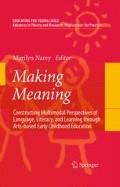In this chapter, we explore children's art learning in different museum environments (archaeological, contemporary, craft) using the in-depth approach. Basic elements of this approach include the child, chorotopos (space/place), the teacher, and time. Our research involves teachers and young children from Greece (area of Thessaloniki, Northern Greece) and Cyprus (Lefkosia) and suggests that children's contact with a range of art exhibits in museums and other cultural settings is an important part of children's educational meaning making experiences if appropriate approaches and methods are used.
Access this chapter
Tax calculation will be finalised at checkout
Purchases are for personal use only
Preview
Unable to display preview. Download preview PDF.
References
Anderson, D., Piscitelli, B., Weier, K., Everett, M., & Tayler, C. (2002). Children's museum experiences: Identifying powerful mediators of learning. Curator, 45(3), 213–231
Danko-McGhee, K. (2006). Favorite artworks chosen by young children in a museum setting. International Journal of Education through Art, 2(3), 223–235
Duffy, B. (1998). Supporting creativity and imagination in the early years. Buckingham: UK: Open University Press
Durrant, S. R. (1996). Reflections on museum education at Dulwich picture gallery. Art Education, 49(1), 15–24
Epstein, A. S., & Trimis, E. (2002). Supporting young artists: The development of the visual arts in young children. Yipsilanti, MI: High Scope Educational Research Foundation
Falk, J. H., & Dierking, L.D. (2000). Learning from museums: Visitor experiences and the making of meaning. Walnut Creek, CA: AltaMira Press
Freedman, K. (2003). Teaching visual culture. Curriculum, aesthetics and the social life of art. New York: Teachers College Press
Gardner, H., Winner, E., & Kircher, M. (1975). Children's conceptions of art. Journal of Aesthetic Education, 9(3), 60–77
Gardner, H., & Perkins, D. (1989). Art, Mind and Education. Research from Project Zero. Champaign, IL: University of Illinois Press
Gergen, K. J. (1995). Social construction and the educational process. In L.P. Steffe and J. Gale. (Eds.), Constructivism in education (p. 17–39). Mahwah, NJ: Lawrence Erlbaum
Hein, G. E. (1998). Learning in the Museum. London: Routledge
Hohmann, M., & Weikart, D. P. (2002). Educating young children: Active leaning practices for preschool and child care programs. Ypsilanti, MI: High Scope Press
Hooper-Greenhill, E. (1991). Museum and gallery education. Leicester, UK: Leicester University Press
Hooper-Greenhill, E., & Mousouri, T. (2002). Researching learning in museums and galleries 1990–1999: A bibliography review. Leicester, UK: University of Leicester Research Centre
Housen, A. (1987). Three methods for understanding museum audiences. Museum Studies Journal, 2(4), 41–50
Kerlavage, M. (1995). A bunch of naked ladies and a tiger: Children's responses to adult works of art. In C. Thompson (Ed.), The visual art in early childhood learning (pp. 56–62). Reston VA: National Art Association
Lave, J., & Wenger, E. (1991). Situated learning: Legitimate peripheral participation. Cambridge: Cambridge University Press
Parsons, M., Jorhnston, M., & Durham, R. (1978). Developmental stages in children's aesthetic responses. Journal of Aesthetic Education, 12(1), 83–104
Piscitelli, B., & Anderson, D. (2000). Young children's learning in museum settings. Visitor Studies Today, 3(3), 1–20
Philips, D. C. (1995). The good, the bad and the ugly: The many facets of constructivism. Educational Researcher, 24(7), 5–12
Savva, A., Trimis, E., & Zachariou, A. (2004). Exploring the links between visual arts and environmental education: Experiences of teachers participating in an in-service training programme. International Journal of Art & Design, 23(3), 246–255
Savva, A. (2003). Young pupils' responses to adult works of art. Contemporary Issues in Early Childhood Education, 4(3), 300–313
Savva, A., & Trimis, E. (2005a). Responses of young children to contemporary art exhibits: The role of artistic experiences. International Journal of Education and the Arts, 6(13). Retrieved from http://www.ijea.org/v6n13/
Savva, A., & Trimis, E. (2005b). Linking children's museum experiences with art educational programmes in pre-primary schools: The case of Cyprus Archeological Museum. Educational Review, 39, 115–132. (In Greek)
Silverman, L. (1995). Visitor meaning-making in museums for a new age. Curator, 38(3), 161– 170
Stephens, K. (1999). Primed for learning: The young child's mind. Child Care Information Exchange, 3, 44–48
Taunton, M. (1984). Aesthetic responses of young children to the visual art: A review of the literature. Journal of Aesthetic Education, 16(3), 93–109
Thompson, C. M. (2005). Images of the child in art and art teacher education. Art Education, 58 (2), 18–24
Trimis, E. (1996). A developmental art program for pre-school education based on the principles of holistic an in-depth approach method. O.M.E.P (In Greek). Researching the Child's World, 2, 137–151. (In Greek)
Trimis, E., & Manavopoulos, C. (2001). Promoting the creative abilities of young children through a visual art program with seemingly scrap materials. In Kouth, E. (Ed.) Research in the pre school educational, instructive methodology (pp. 115–132). Athens: Tipothito. (In Greek)
Trimis, E., & Savva, A. (2004). The in-depth studio approach: Incorporating an art museum program into a pre-primary classroom. Art Education, 57(6), 20–36
Trimis, E., & Savva, A. (in press). Artistic learning in relation to young children's chorotopos: An in depth approach to early childhood visual culture education. Early Childhood Education Journal
Author information
Authors and Affiliations
Editor information
Editors and Affiliations
Rights and permissions
Copyright information
© 2009 Springer Science+Business Media, LLC
About this chapter
Cite this chapter
Trimis, E., Savva, A. (2009). The In-Depth Approach: Young Children's Artistic Learning in the Context of Museum Environments and Other Cultural Settings. In: Narey, M. (eds) Making Meaning. Educating the Young Child, vol 2. Springer, New York, NY. https://doi.org/10.1007/978-0-387-87539-2_6
Download citation
DOI: https://doi.org/10.1007/978-0-387-87539-2_6
Publisher Name: Springer, New York, NY
Print ISBN: 978-0-387-87537-8
Online ISBN: 978-0-387-87539-2
eBook Packages: Humanities, Social Sciences and LawEducation (R0)

